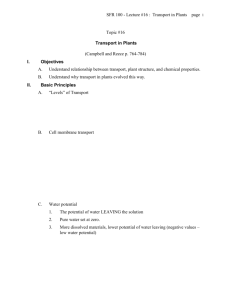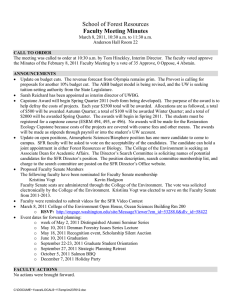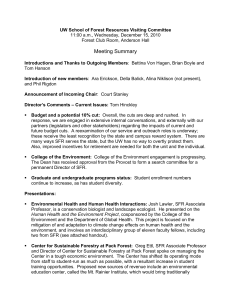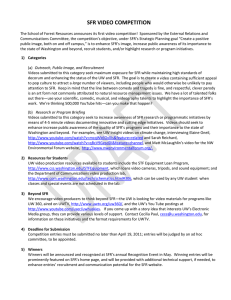Shape-Function-Relationship (SFR) framework for semantic interoperability of product model
advertisement
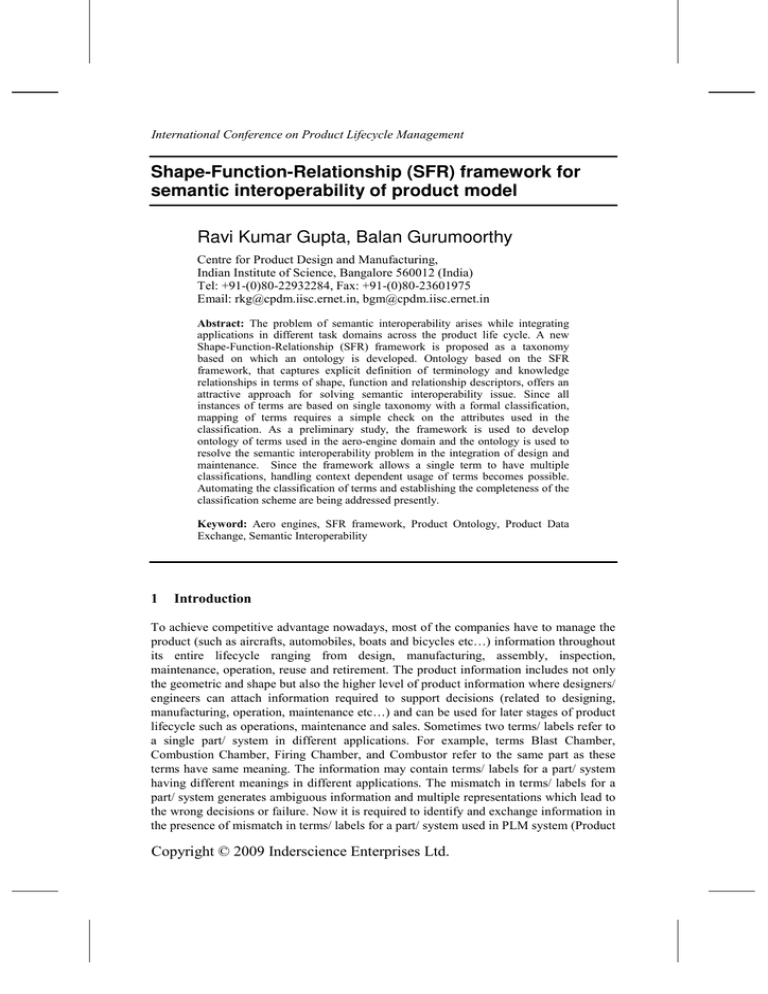
International Conference on Product Lifecycle Management
Shape-Function-Relationship (SFR) framework for
semantic interoperability of product model
Ravi Kumar Gupta, Balan Gurumoorthy
Centre for Product Design and Manufacturing,
Indian Institute of Science, Bangalore 560012 (India)
Tel: +91-(0)80-22932284, Fax: +91-(0)80-23601975
Email: rkg@cpdm.iisc.ernet.in, bgm@cpdm.iisc.ernet.in
Abstract: The problem of semantic interoperability arises while integrating
applications in different task domains across the product life cycle. A new
Shape-Function-Relationship (SFR) framework is proposed as a taxonomy
based on which an ontology is developed. Ontology based on the SFR
framework, that captures explicit definition of terminology and knowledge
relationships in terms of shape, function and relationship descriptors, offers an
attractive approach for solving semantic interoperability issue. Since all
instances of terms are based on single taxonomy with a formal classification,
mapping of terms requires a simple check on the attributes used in the
classification. As a preliminary study, the framework is used to develop
ontology of terms used in the aero-engine domain and the ontology is used to
resolve the semantic interoperability problem in the integration of design and
maintenance. Since the framework allows a single term to have multiple
classifications, handling context dependent usage of terms becomes possible.
Automating the classification of terms and establishing the completeness of the
classification scheme are being addressed presently.
Keyword: Aero engines, SFR framework, Product Ontology, Product Data
Exchange, Semantic Interoperability
1
Introduction
To achieve competitive advantage nowadays, most of the companies have to manage the
product (such as aircrafts, automobiles, boats and bicycles etc…) information throughout
its entire lifecycle ranging from design, manufacturing, assembly, inspection,
maintenance, operation, reuse and retirement. The product information includes not only
the geometric and shape but also the higher level of product information where designers/
engineers can attach information required to support decisions (related to designing,
manufacturing, operation, maintenance etc…) and can be used for later stages of product
lifecycle such as operations, maintenance and sales. Sometimes two terms/ labels refer to
a single part/ system in different applications. For example, terms Blast Chamber,
Combustion Chamber, Firing Chamber, and Combustor refer to the same part as these
terms have same meaning. The information may contain terms/ labels for a part/ system
having different meanings in different applications. The mismatch in terms/ labels for a
part/ system generates ambiguous information and multiple representations which lead to
the wrong decisions or failure. Now it is required to identify and exchange information in
the presence of mismatch in terms/ labels for a part/ system used in PLM system (Product
Copyright © 2009 Inderscience Enterprises Ltd.
R.K. Gupta and B. Gurumoorthy
Lifecycle Management) to provide the right information at the right time for the right
decision. As applications are geographically distributed, the semantic interoperability
becomes more important to support today's globally distributed environment.
Semantic interoperability in the shape domain can be addressed by reasoning about
geometry alone [1, 2]. However when domains such as operations and maintenance are
involved shape information is insufficient to capture semantic information of different
parts/ systems used. This is because labels of two parts/ products with same shape are
different because they serve different functions. Authors are therefore proposing ShapeFunction-Relationship (SFR) framework to capture semantic of a part/ system of an aero
engine used in different stages of PLM e.g. manufacturing, operation, maintenance, sales
catalogue etc... SFR structure provides unique representation of a part/ system. Ontologydriven SFR framework, based on explicit definitions of terminology and knowledge
relationships in terms of shape, function and relationship descriptions, offers an attractive
approach for solving semantic interoperability issue. Elements of SFR framework with
ontology has been described in the following sections. The framework is presented for
aero engine as to clarify elements of SFR structure with developed ontology. The
reasoning module has been demonstrated with a case study for aero engine.
2
Literature review
The problem of semantic interoperability has been addressed primarily in the domain of
shape modeling in the context of exchange of CAD models between different CAD
systems [1-4]. A different flavour of this problem manifests while integrating
applications in different task applications across the product life cycle. For instance,
integrating design and maintenance applications will require handling multiple terms
used for the same entity as the maintenance information is often created by different
actors. Tasks such as information retrieval for design reuse also encounter the
interoperability problem. There are two broad approaches in the literature to address this
problem. The first uses multiple ontologies (specific to each application) and providing
mapping between these multiple ontologies to match terms/ entities with same semantics
[5, 6]. The mapping involves both syntax and semantics. The second approach involves
the development of a single ontology by capturing, through enumeration, synonyms of
entities in use [7-9].
The use of ontologies to address the information extraction problem has been
addressed by several researchers. Papers [5, 6] focus on unstructured design documents
and address the problem of improving information retrieval and extraction using
ontology. They use a shallow NLP technique to automatically populate ontology
instances according to domain ontologies. Compared to a keyword-based retrieval
method, the proposed method is able to retrieve larger number of correct documents by
exploiting the hierarchical organization of concepts. A total number of six domain
ontologies, device, performance, function, material, manufacturing process, and
environment, are used as domain ontologies. Multiple taxonomies are used to build an
Engineering Ontology and the relationships are found across these taxonomies.
Taxonomy is used to classify parts/ words/ phrases (called concepts) that appear in a
domain. Each word/ phrases may appear many times in different taxonomies and
resolving the ambiguity is computationally very expensive as described in papers.
Ambiguities are resolved by referring to the content of the words/ phrases that match with
SFR framework for semantic interoperability of product model
multiple concepts. The domain/ taxonomy name has to be in query to find a particular
concept.
The paper [9] reviews recent works on ontologies in engineering domain and
compared them using pre-defined comparison criteria. These ontologies are mainly used
to address the interoperability problem due to heterogeneity in data models. The paper [8]
describes a six stage methodology for building an ontology for engineering design that
composed of four root concepts, i.e. Issue, Product, Function and Design Process. The
application is to improve indexing and retrieving information from unstructured
documents. Each term in the ontology has a label name (visible to users) and its
synonyms.
The paper [7] presents an ontology-based document management approach focusing
on information extraction and users’ comments. The proposed solution uses an automatic
identification of named entities (NE) through information extraction (IE) technique and
document searches based on NE. Sample texts (137 documents) have been analysed in
order to identify how ‘Product’ names were referred to in texts.
The work published in papers [1-4] is focused only on exchanging shape information,
where shape information is used to describe features in a product model. The paper [2]
has used DIFF model [10, 11] to describe shape information of a product model and
DIFF ontology is developed to resolve semantic interoperability. DIFF structure provides
a unique representation of features in a product model. The reasoning module with
examples is described in the papers.
3
Aero – engine
The most common type of aero engine is the turbojet engine. Air from the atmosphere
enters into the fan section at the front of the engine where it is compressed in the
compressor section. Then it is forced into combustion chambers where fuel is sprayed
into it and ignited. Gases that form expand rapidly and are exhausted out the rear of the
combustion chamber. The energy from these gases spins the fan-like set of blades called
a turbine, which rotates the turbine shaft. This shaft, in turn, rotates the compressor,
thereby bringing in a fresh supply of air through the intake at the front of the engine. The
rest of the energy is expelled out through the tail pipe or propelling nozzle, providing
forward thrust. Adding an afterburner section, where extra fuel is sprayed into the gases
as they are exhausted and the fuel burns, adds thrust. Some parts of an aero-engine are
shown in figure 1.
Figure 1
Parts of an aero-engine [12, 13]
R.K. Gupta and B. Gurumoorthy
4
Semantic information exchange
When integrating applications, substantial difficulties can arise in translating information
from one application to the other. Applications may use different terminologies to
describe the same shape. Even when applications use the same terminology, they often
associate different semantics with the terms or represent different parts/ systems. This
obstructs information exchange among applications. The authors are focusing on
identifying and capturing the terms/ labels of parts/ systems and enabling semantic
integration of disparate information throughout the Product Lifecycle. Our work proposes
an ontology based approach to enable such semantic interoperability.
4.1 Types of semantic interoperability
There are two types of semantic interoperability issues to be handled as required while
exchanging information among applications. Work is specific to the use of aerospace
terms.
i.
One part/ system (entity) has two or more names
ii.
Two or more parts/ systems (entities) have same term/ name
These types of semantic interoperability issues have been described with examples in
the following subsections.
4.1.1 One part/ system (entity) has two or more names
This case refers to one part having multiple labels. Terms used may refer to a part / object
with in an application as shown in table 1. For example the part “Combustion Chamber”
may appear in documents as Blast chamber, Combustion chamber, Burner, Chamber,
Firing chamber or Combustor. Similarly, Afterburner is also referred to as “Reheater” in
some geography. A list of linguistic features (Singular/ plural, Acronym, Syntactic
variation, Lexical variation, Compounds words pattern, Separate reusable suffix, Separate
reusable modifier, Context) with their examples are described in paper [7]. These
variations are come under this type of semantic interoperability issue. The papers [7-8]
have solved this type of semantic interoperability issue by grouping and enumerating
terms under synonyms of one term.
Table 1
One part/ system (entity) has two or more names
Part
Part names/ terms
Combustion chamber
Blast chamber, Combustion chamber, Firing chamber, Combustor
Rotor blade
Rotor blade, Impeller blade, bucket, Rotating blade
Turbine wheel
Disc, Drum, Turbine wheel
Blade
Vane, Blade , Bucket
4.1.2 Two or more parts/ systems (entities) have one name
One name/ label may refer to two or more parts. Example of this type of issue is the label
blade that could be referring to a compressor blade, turbine blade, stator blade or rotor
blade (table 2). A part name/term has multiple representations referring to multiple parts.
Though the parts have commonalities at higher levels of abstraction, the distinctions
appear at a more detailed level. For example Compressor Stator Blade and Turbine Stator
SFR framework for semantic interoperability of product model
Blade have some common features but represent different parts. It is context dependent
but the context may not be explicitly defined in the text or may be defined somewhere.
Table 2
Two or more parts/ systems (entities) have one name
Part name/ term
Part
I
II
III
Blade
Vane
Bucket
Compressor Blade
Rotor blade of
Compressor
Stator blade of
Compressor
Disc
Fan Disc
Turbine wheel
Compressor Disc
Case
Fan Case
Turbine Case
Compressor Case
Authors propose to describe part/ system in terms of descriptors of shape, function
and relationship. These descriptors are used to describe shape of the part/ system,
function of the part/ system and relationship with other part/ system. The entries
(instances) against these descriptors of SFR structure are used to describe part/ system
uniquely.
4.2 Reasoning module
Product with its assemblies/ sub assemblies/ parts are first describe in terms of SFR
structure and the description is used to reason and find equivalent terms used in required
application. SFR ontology is used to capture and has semantic terms of SFR structure.
The query feature of the ontology editor is used to find semantically equivalent terms for
the term being exchanged. Applications such as information retrieval, search service
manual, automatic plan generation, live updates are added advantages.
5
Shape-Function-Relationship (SFR) framework
Authors have defined attributes of the SFR structure as generalized as possible so that
most of the parts/ systems of a product can be defined in SFR framework. A part/ system
of a product can be defined uniquely in the SFR framework so as to achieve semantic
interoperability among applications.
The SFR structure is used to visualize product in terms of shape of part/
assembly, function of part/ assembly and relationship of part/ assembly with other parts/
assemblies. Presently, different attributes of SFR structure are entered manually and
some attributes of function will require knowledge about the product. Elements of SFR
framework are described in the following subsections. The following subsection also
describes how to capture semantic of a product in the SFR structure. Development of
ontology based on the SFR framework is described in the next section.
5.1 Shape definition
The shape element of SFR framework is used to describe shape of the product in terms of
parts in the product. These parts have form and material to describe the product. The
product is linked to the product 3D model/ image to identify parts/ components in the
R.K. Gupta and B. Gurumoorthy
product and their form and material. The identified values are the input values for the
shape definition of the SFR structure and used in the reasoning. The attributes/
parameters used to describe the Shape element of the SFR structure is depicted in table 3.
Shape = F (Form, Material, Parts, Product 3D model/ image)
Form = F (Form of individual part in the product) = F (FP1, FP2, FP3 … FPn)
Material = F (Material of individual part in the product) = F (MP1, MP2, MP3
… MPn)
Parts = F (Parts/ components in the product) = F (PT1, PT2, PT3 … PTn)
Product 3D model/ image = F (Link of the 3D model/ image of the product)
Table 3
Attributes/ parameters used to describe the Shape element.
Form
Material
Parts
FP1, FP2 … FPn
MP1, MP2 … MPn
PT1, PT2 … PTn
Product 3D model/
image
5.2 Function definition
The function element of SFR framework is used to describe part/system in terms of
working medium used and part/ system itself as follows.
Function = F (Working medium, Part/ system)
Working medium = F (Parameters to describe working medium,
Medium _in_contact)
Part/system = F (Motion of part/ system)
Where: Parameters to describe working medium = Velocity, Pressure,
Temperature in the case of aero-engine.
The attributes/ parameters used to describe the function element of the SFR structure
is depicted in table 4.
Table 4
Attributes/ parameters used to describe the Function element.
Velocity of
fluid
Pressure of
fluid
Temperature
of fluid
Medium_in_contact
Motion of
part/system
5.3 Relationship definition
This element of SFR framework is used to describe product in terms of i. relationship
with other parts/ assemblies based on spatial and functional sequence, ii. component of or
super-assembly of as follows.
Relationship = F (Relationship with other parts/ assemblies, component of)
= F (Before, After, Component_of)
Table 5 shows the attributes used to define the Relationship element of SFR structure.
The relationship definition of a product “Combustion Chamber” is also depicted in the
table where attributes Before, After and Component_of have values as Compressor,
Turbine and Aero engine respectively. The functional sequence in aero engine is IntakeCompressor-Combustion Chamber-Turbine-Nozzle-Exhaust (Figure 2).
SFR framework for semantic interoperability of product model
Table 5
Attributes/ parameters used to describe the Relationship element.
Before
After
Component_of
Relationship definition for “Combustion Chamber”
Compressor
Turbine
Aero engine
Figure 2
Spatial and functional sequence of an aero engine [14]
Figure 3
Schematic diagram of the process for identification of mismatch in terms/ labels for a
product
A term “Y” representing part “X”
from a document in one application
Ontology
for SFR
SFR of term “Y” representing part “X”
with Parameters P1, P2, P3 …Pn
Multi terms {Z1, Z2, Z3 …Zn} representing
part “X” with SFR parameters
Interface
is used
Select a term representing part
“X” for another application
A term “Z” representing part “X”
for a another document
5.4 Semantic definition of a product
A product consists of assembly, subassemblies and parts with their relationship. Authors
have analyzed and represented most commonly used terms of aero engine occurring in
product, production, sales and maintenance manuals. A part can be uniquely represented
by SFR structure. Sometimes the definition of one element of SFR structure is same for
two products but at the same time the definition of other two elements will be different.
R.K. Gupta and B. Gurumoorthy
So a part can be uniquely represented by group of Shape, Function and Relationship
elements of the SFR structure. For example, two parts (turbine rotor blade and
compressor rotor blade) have the same function but difference can be captured by shape
and relationship elements. If two terms have same SFR structure, the two terms are
semantically equivalent. The SFR definition of the term is used for reasoning. The
module flashes all the terms that are semantically same for this term. One term from a
group of terms for the part can be selected for the required application. Schematic
diagram of the process for identification of mismatch in terms/ labels for a product is
depicted in figure 3. The proposed method for semantic interoperability of a product
using SFR Framework is implemented using Protégé ontology editor [15]. Screen shot of
different parts of SFR model is shown in the following sections.
6
Shape-Function-Relationship (SFR) ontology
The structure defined in section 5 is used to develop ontology of a product. Protégé
ontology editor [15] is used to develop ontology for SFR (Shape- Function-Relationship)
model. All terms are classified in terms of the criteria described in section 5. Figure 4
shows the class hierarchy with attributes and attributes’ values for a product “Combustion
Chamber”. The parameters/ attributes that are associated with combustion chamber and
used in the reasoning are shown in the right panel of the figure 4. Different terms
associated with a part refer to the possible ways the part can be termed in different
applications. The user defined term is a place holder for term/ label of a product and also
for further extension of the SFR ontology to handle parts that are not defined.
Figure 4
The class hierarchy of the SFR model with attributes and attributes’ values for
“Combustion Chamber”
Shape
Function
Relationship
SFR framework for semantic interoperability of product model
The attributes with their possible values of the shape, function and relationship
elements are defined in table 6, table 7 and table 8 respectively. An example of each
element is also described in the tables. Each attribute has a value from a set of predefined
values. For example parameter “Velocity of fluid” in function element can be Decrease,
Increase, Constant, Radial or Axial. The part with two terms can be identified by the
reasoning module as both terms have same SFR structure. Two parts with single term/
name can be differentiated by the reasoning module as both parts have different SFR
representations. Implementation to identify the mismatch in part terms/ labels among
applications is described in the following sections.
Table 6
Attributes/ parameters and their possible values used to describe the Shape element.
Form
Material
Parts
FP1, FP2 … FPn
MP1, MP2 … MPn
PT1, PT2 … PTn
Product 3D model/
image
Allowable values (String type)
Product: Turbine shaft
Cylindrical
Table 7
MP1
Turbine shaft
Attributes/ parameters and their possible values used to describe the Function element.
Velocity of
fluid
Pressure of
fluid
Temperature
of fluid
Medium_in_contact
Motion of
part/system
Allowable values (symbol type )
Decrease
Decrease
Decrease
air_in_air_out
Stationary
Increase
Increase
Increase
air_fuel_in_gas_out
Moving
Constant
Constant
Constant
gas_in_gas_out
Translation
Radial
air_in_contact
Rotation
Axial
gas_in_contact
Product: Combustion Chamber
Increase
Table 8
Increase
Increase
air_in_gas_out
Stationary
Attributes/ parameters and their possible values used to describe the Relationship
element.
Before
After
Component_of
Product: Combustion Chamber
Compressor
Turbine
Aero engine
6.1 Handling one part/ system (entity) has two or more names
The reasoning module shows multiple terms/ names are same as they have one SFR
representation and therefore refer to one part. Figure 5 shows SFR representation (big left
panel in the figure) of a “Combustor”. The multiple terms which represent the same SFR
representation as “Combustor” are shown in the right side panel of the figure. Thus the
R.K. Gupta and B. Gurumoorthy
SFR representation of a term in an application is used to i. find out equivalent terms for
another application which represent the same part/ system or ii. Check if the given terms
represent the same part or not.
Figure 5
Handling one part/ system (entity) has two or more names
Multiple terms /
names represent
one part
“Combustor”
6.2 Handling two or more parts/ systems (entities) have one name
A term representing two or more parts/systems will correspond to two or more SFR
representations. The reasoning module is used to search multiple SFR representations for
multiple parts referring to one term/ name (figure 6). User has to select an appropriate
SFR representation for the term being used. For example “Compressor Blade” has
SFR_A and SFR_B to represent “Rotor blade of a compressor” and “Stator blade of a
compressor” respectively (figure 7). An interface is provided to visualize different SFR
structures and to select an appropriate SFR structure for a particular application. The
parts “Rotor blade of a compressor” and “Stator blade of a compressor” have some
commonalities at higher levels of abstraction but the distinctions appear at the lower
level. Context can be incorporated by clustering terms related to a particular application.
Once a cluster is identified for an application then search with in the cluster becomes
easy. This way search can be narrow down and handling of context can be brought in the
reasoning.
SFR framework for semantic interoperability of product model
Figure 6
Handling two or more parts/systems (entities) have one name
Multiple parts for a term
“Compressor Blade”
Figure 7
Multiple SFR representation for a tem “Compressor Blade”
SFR_A
7
SFR_B
Conclusions and future work
A taxonomy based on Shape, Function and relationship has been proposed to build an
ontology that can be used to address semantic interoperability problem between different
task domains. An ontology for the aero engine space has been developed and used to
address mismatch of labels of parts between maintenance and design domains. Currently
the ontology is constructed manually. Automatic means to extract the labels and build
their representation in the SFR framework is being explored.
The work presented in the paper is a part of ongoing research. Ability of
the SFR framework to uniquely describe the products in other domains is to be
R.K. Gupta and B. Gurumoorthy
investigated next. Attempts are being made to build SFR based description
for the machine tool domain. The authors are working on using the SFR
model with IPPOP model [16] to explore use of product data to support
decision-making. The authors are also working to combine SFR model with
the core product model (CPM) [17].
References
1
2
3
4
5
6
7
8
9
10
11
12
13
14
15
16
17
Gupta, R.K., Gurumoorthy, B. (2008A) ‘Extending feature based semantic interoperability
for sheet-metal features’, International Conference on Trends in Product Life cycle
Modelling, Simulation and Synthesis (PLMSS08), India.
Gupta, R.K., Gurumoorthy, B. (2008B) ‘A Feature Based Framework for Semantic
Interoperability of Product Models’, Strojniski vestnik – Journal of Mechanical
Engineering, Vol.54, No.6, pp. 446-457.
Patil, L., Dutta, D., Sriram, R. (2005) ‘Ontology-Based Exchange of Product Data
Semantics’, IEEE Transactions on Automation Science and Engineering, Vol. 2, No. 3, pp.
213-225.
Mostefai, S., Bouras, A. Batouche, M. (2005) ‘Effective Collaboration in Product
Development via a Common Sharable Ontology’, International Journal of Computer
Intelligence, Vol. 2, No. 4, pp. 206-212.
Li, Z., Ramani, K. (2007) ‘Ontology-based design information extraction and retrieval’,
Journal of Artificial Intelligence for Engineering Design, Analysis and Manufacturing, Vol.
21, no. 2, pp. 137–154,
Li, Z., Raskin, V., Ramani, K. (2008) ‘Developing Engineering Ontology for Information
Retrieval’, ASME Transactions Journal of Computing and Information Science in
Engineering, Vol. 8, no. 1, pp. 1-13.
Kim, S., Ahmed, S., Wallace, K.M. (2006) ‘Improving document accessibility through
ontology-based information sharing’, 6th International Symposium on Tools and Methods of
Competitive Engineering (TMCE 2006), 18-22 Apr 2006, Ljubljana, Slovenia.
Ahmed, S., Kim, S., Wallace, K.M. (2007) ‘A methodology for creating ontologies for
engineering design’, ASME Transactions Journal of Computing and Information Science in
Engineering, Vol.7, no.2, pp. 132-140.
Kim, S., Bracewell, R., Wallace, K.M. (2008) ‘Some reflections on ontologies in
engineering domain’, 7th International Symposium on Tools and Methods of Competitive
Engineering (TMCE 2008), 21-25 April 2008, Izmir, Turkey.
Nalluri, S.R.P.R. (1994) ‘Form feature generating model for feature technology’, PhD thesis,
Indian Institute of Science, Department of Mechanical Engineering, Bangalore, India.
Subramani, S. (2005) ‘Feature mapping, associativity and exchange for feature-based
product modeling’, PhD thesis, Indian Institute of Science, Department of Mechanical
Engineering, Bangalore, India.
GKN Aerospace, (2008), http://www.gknaerospace.com/
Wikipedia, (2009), http://en.wikipedia.org/wiki/Turbofan
Autonomous System Lab, (2008), http://asl.epfl.ch/
Protégé, (2008) ‘Protégé Ontology Editor’, Stanford University, http://protege.stanford.edu/
IPPOP (Integration of Product, Process and Organisation for engineering Performance
Improvement) is a French RNTL network project labelled by the French Ministry of
Economy, Finances and Industry More information on http://ippop.laps.u-bordeaux1.fr/
Fenves, S.J., Foufou, S., Bock, C., Sudarsan, R., Bouillon, N., Sriram R.D. (2004) ‘CPM2: A
Revised Core Product Model for Representing Design Information’, National Institute of
Standards and Technology, NISTIR 7185, Gaithersburg, MD 20899, USA.
